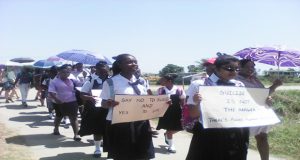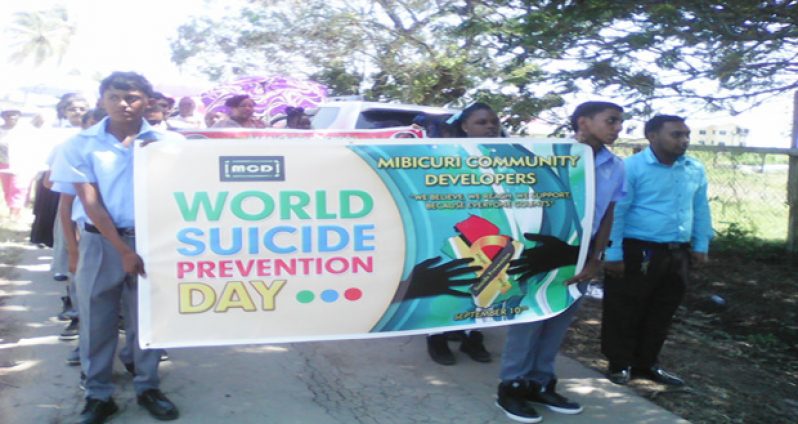THE Ministry of Social Protection held a march and rally last Thursday at Black Bush Polder on the Corentyne, in Region 6, to commemorate World Suicide Prevention Day.Addressing attendees, Minister of Social Protection Ms Volda Lawrence, declared: “I empathise with families who have lost loved ones. And the community…it is imperative that we spare no effort…we have to let our voices resonate across Guyana, more so in Region 6…we need to say a loud ‘No!’ to this social ill and a resounding yes to life.”
She opined that the family structure must be restored, and youths must find persons with whom they could share their problems without fear. In so doing, she said, suicide could be avoided.
She explained further that trained counsellors need to interact more within communities, and experienced health- care workers need to provide a forum for persons suffering from depression and abuse.

She expressed that forums must be created to encourage depressed and suicidally-inclined persons to leave their friends and communicate with trained counsellors their problems and difficulties in an atmosphere of confidentiality.
Acknowledging that the Ministry of Social Protection was unable to undertake this mammoth task single-handedly because it lacks the manpower and skills to fight this social ill, the minister said
plans are currently on stream to host a two-day workshop with non-governmental organisations across the country, so as to formulate a plan to fix the broken fabric of society.
It is envisaged that any legislation or security measure which needs to be established to support The Prevention of Suicide Act will be endorsed by Minister Khemraj Ramjattan, who was unavoidably absent from the forum because he has contracted the flu.
Moreover, she informed the audience that during the sitting of the National Assembly on Wednesday, ministers, inclusive of Public Health Minister Dr George Norton, began reviewing the Pesticide Act and they are expected to bring an amendment to ensure that persons who use pesticides take more care with them and are more responsible for such items.
Earlier, representatives of the secondary schools in East Berbice/ Corentyne had braved the intense heat of the mid-morning sun as they shouted: “Say no to suicide, yes to life,” whilst making the half- mile trek to the Black Bush Polder Secondary School, where the annual rally was held under the theme, ‘Reaching out, saving lives.’
The Black Bush community has one of the highest rates of suicide in Guyana, and the incidents always leave survivors traumatised and stigmatised. This is not confined to suffering families only, but the entire community which would have lost the valuable skills and expertise of the deceased.
Organised by the Mibicuri Community Developers (MCD), an 18-year-old non-governmental organisation (NGO), it is expected that all efforts would be intensified so as to remove the stigma and taboo of suicide.
The NGO currently focuses on suicide prevention and promotion of community development in the agriculture-based community situated off the Corentyne coastline.
Ms Verma Jadunath painted a grim picture of the situation after conducting personal research in her home village over the last nine months. That research revealed that thirty-seven (37) persons had attempted suicide and were hospitalised at the Mibicuri Cottage Hospital.
Further, July had the highest recorded cases of suicide — eight (8) — with January having six (6), August and June five (5), April and May four (4), February 1, and the current month September, two (2). Of those hospitalised, two had died.

Referring to the 2012 survey by MCD, which was researched by Michael I.J. Fallahay, a Peace Corps Response Volunteer, Judunath said no particular reason was given for committing suicide; however, the act was aided by easy accessibility of agro chemicals in the community.
In her remarks, Minister in the Public Health Ministry Dr Karen Cummmings, reflected that the dilemma is a serious public health concern, which she said has both immediate and far- reaching effects on families and communities.
“Globally, the suicide rate is 10.3 per 100,000, but in Guyana the rate is 44.2 per 100,000, making it the highest in the world,” Dr Cummings said.
“It was Dr. Bernadette Theodore Ghandi, a PAHO representative in Guyana, who said that suicide in Guyana reflects a chronic state of unhappiness and poor mental health that requires urgent action,” she declared.
It was noted that the problem has since worsened, resulting in the government “not sweeping the fact under the carpet,” but are rolling out a national strategy on how to deal with mental health problems. Referring to a study dubbed “A Shadow of Death” by psychiatrist Dr Beckles, who looked at the causes, incidence and solutions, for suicide; and another conducted by Dr Ken Danns, a former University of Guyana Professor, it was observed that suicide was committed by young males under age 35 who were poorly educated, had been in the same communities all their lives, and were not likely to have children.
Further, she highlighted that the study undertaken by Fallahay noted that East Indians exposed to pesticides are more likely to commit suicide.
In his brief remarks, youth representative Mr Norville Hinds highlighted the suicide of a 12-year-old boy and the challenges faced by an adolescent who experiences periods of tremendous crises.
“It is a period of transition between being dependent and being independent. During that period, there are a lot of changes…it is a period of time when they expect people to reach out to them…. Young people need spaces…they need spaces where they can express themselves freely,” he declared.
U.S. Embassy HAP Director Mr Matthew Radram highlighted failure as the common denominator in suicides. Nevertheless, he said, each person has the calibre to provide hope and purpose for someone else.
The three-hour march and rally was also attended by Region 6 Chairman Mr. David Armogan; Regional Executive Officer Dr Veerasammy Ramayya; Director of Health Services Dr Jevaughn Stephens; education officers and special invitees. It was further punctuated by poetic pieces from six secondary schools, along with messages from all the participating institutions of learning.



.jpg)








